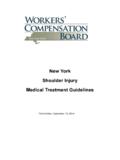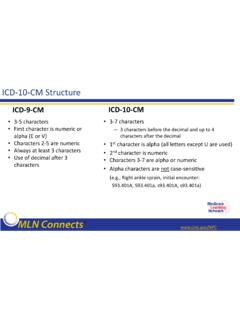Transcription of SPLINTING TECHNIQUES - Emergency Medicine Residents ...
1 BASELINE MATERIALSl Stockinettel SPLINTING materiall Plaster Upper extremity: 8 10 layers Lower extremity: 10 12 layersl Fiberglassl Padding l Elastic bandagingl Bucket/receptacle of water (the warmer the water, the faster the splint sets)l Trauma shears Measure and prepare the SPLINTING Length: Measure out the dry splint on the contralateral extremityl Width: Slightly greater than the diameter of the limbApply the stockinette to extend 2" beyond the SPLINTING 2 3 layers of padding over the area to be splinted and between digits being splinted. Add an extra 2 3 layers over bony moisten the SPLINTING material.
2 Place it and fold the ends of stockinette over the SPLINTING the elastic still wet, use palms to mold the splint to the desired hardened, check neruovascular status and motor TECHNIQUESBASELINE | Olecranon fracturesl Humerus fracturesl Radial head and neck fracturesCONSTRUCTIONl Start at posterior proximal arml Down the ulnar forearml End at the metacarpophalangeal jointsAPPLICATIONl Cut hole in stockinette for thumbl Elbow at 90 l Forearm neutral position with thumb upl Neutral or slightly extended wrist (10 20 )INDICATIONSl Soft tissue injuries of the hand and wristl Carpal bone fracturesl 2nd 5th metacarpal head fracturesCONSTRUCTIONl Start at palm at the metacarpal headsl Down the volar forearml End at distal forearmAPPLICATIONl Cut hole in stockinette for thumbl Forearm in neutral position with thumb upl Wrist slightly extended (10 20 )l Like holding a canINDICATIONSl Complex and unstable forearm and elbow fracturesCONSTRUCTIONl Forearm splint.
3 As abovel Arm splint Start at anterior proximal humerus Around elbowl End at posterior proximal humerusAPPLICATIONl Cut hole in stockinette for thumbl Elbow at 90 l Forearm neutral with thumb upl Slightly extended wrist (10 20 )POSTERIOR LONG ARM SPLINTVOLAR SPLINTINDICATIONSl Distal radius and ulna fracturesCONSTRUCTIONl Metacarpal heads on the dorsal handl Around elbowl End at volar metacarpal phalangeal jointsAPPLICATIONl Cut hole in stockinette for thumbl Elbow at 90 l Forearm neutral with thumb upl Slightly extended wrist (10 20 )SUGAR TONG SPLINTDOUBLE SUGAR TONG | Fractures and soft tissue injuries of index and 3rd digitsl Fractures of the neck, shaft and base of the 2nd and 3rd metacarpalsCONSTRUCTIONl Starts at mid-forearml Down the radial forearml End mid-distal phalanx of 2nd and 3rd digitsAPPLICATIONl Cut hole in stockinette and SPLINTING material for the thumbl Hand in position of functionl Forearm in neutral positionl Wrist slightly extendedl MCP 50 of flexionl Proximal interphalangeal and distal interphalangeal joints 5 10 flexionINDICATIONSl Injuries to scaphoid, lunate.
4 Thumb and 1st metacarpall Gamekeeper s/Skier s thumbl De Quervain tenosynovitisCONSTRUCTIONl Start at mid-distal phalanx of thumbl End at mid-forearmAPPLICATIONl Cut hole in stockinette for thumbl Cut wedges on both sides of SPLINTING material at MCP jointl Forearm in neutral position with thumb in wineglass positionINDICATIONl Mallet FingerCONSTRUCTIONl Splint only the distal interphalangeal jointAPPLICATIONl Splint distal interphalangeal joint in hyperextensionl DIP must remain in continuous extension for 6 8 weeksINDICATIONl Phalanx fracturesl Tendon repairsCONSTRUCTIONl Splint across fractured phalanx or repaired tendonAPPLICATIONl If tendon repair.
5 Splint in flexion or extension, depending on tendon repairedRADIAL GUTTER SPLINTTHUMB SPICA SPLINTINDICATIONSl Fractures and soft tissue injuries of 5th digitl Fractures of the neck, shaft, and base of 4th and 5th metacarpalsCONSTRUCTIONl Start at mid-forearml Extend down ulnar forearml End at mid-distal phalanxl Include the 4th and 5th digitsAPPLICATIONl Hand in position of functionl Forearm in neutral positionl Wrist slightly extendedl MCP 50 of flexionl Proximal interphalangeal and distal interphalangeal joints 5 10 flexionl If boxer s fracture: flex the metacarpal phalangeal joints to 90 ULNAR GUTTER SPLINTMALLET FINGERFINGER | Compartment syndromel Ischemial Neurologic injuryl Thermal injuryl Pressure sores.
6 Skin breakdownl Infectionl Dermatitisl Joint stiffnessSPLINTING COMPLICATIONSINDICATIONSl Patients with legs too large for knee immobilizerl Angulated fracturesl Injuries that require urgent operative fixationCONSTRUCTIONl Start just inferior to buttocks creasel Down the posterior legl End approximately 6cm above the malleoliAPPLICATIONl Slightly flexed kneeINDICATIONSl Grade 2 Grade 3 ankle sprainsl Fractures of distal fibula and tibial Reduced ankle dislocationsl Can add stirrup splint for unstable ankle fracturesCONSTRUCTION POSTERIOR ANKLEl Start at plantar surface of the metatarsal headsl Extend up posterior legl End at the level of the fibular headCONSTRUCTION STIRRUPl Laterally, start 3 4cm below the level of fibular headl Extend under the plantar surface of footl End at medial and lateral side of leg to just below fibular headAPPLICATIONl Place with the patient in the prone positionl Ankle at 90 l Place posterior ankle splint firstPOSTERIOR KNEE SPLINTPOSTERIOR ANKLE & STIRRUP SPLINTSBoyd A, Benjamin H, Asplund C.
7 Principles of Casting and SPLINTING . Am Fam Physician. 2009 Jan 1;79(1):16 MP, Hatch RL. Fracture Management for Primary Care. Philadelphia, PA: Elsiver/Saunders, Ian Ross, MDStanford/O Connor Hospital, Primary Care Sports Medicine Fellow, 2017 2016 17 Chair, EMRA Sports Medicine Division Member, Figure Skating Sports Science & MedicineILLUSTRATORM atthew HoltBodyrenderREVIEWERAnna L. Waterbrook, MD, FACEP, CAQ-SMUniversity of ArizonaAssociate Professor, Dept. of Emergency Medicine Associate Program Director, South Campus Residency ProgramAssociate Program Director, Sports Medicine FellowshipAssistant Team Physician, Intercollegiate Athletics2016 18 Chair, ACEP Sports Medicine |






